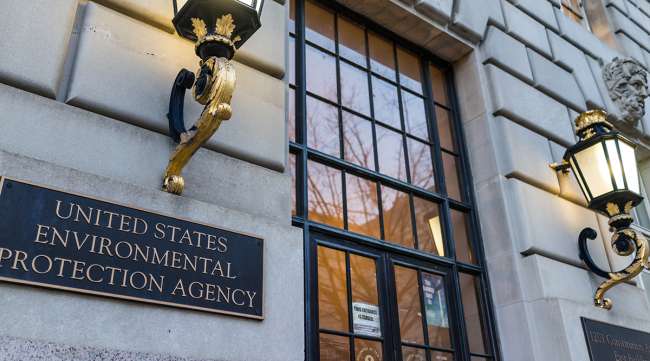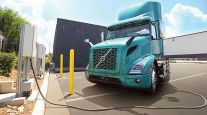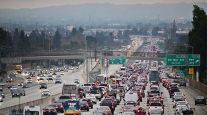Critics Contend EPA Can’t Keep Prior Fuel Economy Data in Its Blind Spot

Lawsuits over EPA’s April fuel economy determination are more than just a pre-emptive strike, challengers say: They’re an effort to force the agency to consider thousands of pages of its own data as it considers weakening emissions limits for passenger cars.
Automakers and others have seen the lawsuits—filed by a group of 16 states led by California, environmental groups, and a coalition including Tesla and several electric utilities—as trying to head off Trump administration plans to sharply weaken the standards. But the challengers say the cases are critical to ensure the Environmental Protection Agency and the Department of Transportation reckon with analysis that agency staff produced during the Obama administration.
RELATED: Millions spent to clean Up California’s diesel trucks, but is it enough?
That extensive record, including a 2016 technical report, proves the current fuel economy standards are achievable, critics argue. And they say if the Trump administration glosses over that analysis and attempts to relax the fuel economy standards based on the limited record EPA presented in its recent determination, it could undercut millions of dollars of investment in fuel-efficient technologies.
“The determination indicates that they have made a decision to weaken the standards. That needs to be based on solid analysis, and it didn’t appear to have been,” Bob Wyman, an attorney with Latham and Watkins in Los Angeles, told Bloomberg.
Wyman represents the National Coalition for Advanced Transportation, which includes Tesla Inc., advanced vehicle companies, and electric utilities such as Exelon Corp. and Pacific Gas and Electric Co.
Pending Proposal
EPA Administrator Scott Pruitt in an April determination said greenhouse gas limits for model years 2022-25 passenger cars must be revised. The agency, along with the National Highway Traffic Safety Administration, could send to the White House as soon as this week plans that could include an option freezing the fuel economy standards at 2020 levels.
RELATED: Trump eyes twice-failed legal strategy to fight California regulations
Pruitt and Transportation Secretary Elaine Chao were scheduled to meet May 23 with top California air official Mary Nichols, but it is uncertain whether they will try to strike a deal. California has the special authority under the Clean Air Act to set its own tailpipe emissions standards and already has adopted the Obama-era limits for model years 2022-25.
It is possible EPA and NHTSA could incorporate data from the prior agency analysis in its any upcoming proposal.
Automakers expect the agencies will outline several options and provide new analysis of the impacts on safety, auto industry jobs and compliance costs for each one.
EPA did not respond to Bloomberg’s query about how it will consider its past analysis for the standards.
NHTSA’s statute is explicit, requiring the agency set the “maximum feasible” fuel economy standard, Gloria Bergquist, vice president of communications and public affairs with the Alliance of Automobile Manufacturers, which represents a dozen major U.S. automakers, told Bloomberg Environment. That requires crunching all the data and making it available for public comment, she added.
Technical Assessment Report
But critics argue the lawsuits challenging Pruitt’s determination are necessary because his decision that the current standards aren’t appropriate will serve as the basis for whatever changes to the program the agencies pursue. That process shouldn’t be divorced from the EPA’s prior analysis, they say.
In particular, supporters of the Obama-era standards point to a roughly 1,200-page technical assessment report that EPA, NHTSA, and the California Air Resources Board issued in 2016.
RELATED: Engine maker Cummins endorses fuel additives amid tighter emissions regulations
That report found that automakers have more technology options available to meet future fuel economy limits, at a similar or lower cost, than had been projected in the original 2012 rulemaking.
Pruitt said last year EPA wouldn’t reopen the technical assessment report, but his determination made little mention of it. Instead, it largely summarized comments and data that automakers and other groups submitted, and it argued trends such as sales and gas prices have shifted to warrant changing the standards.
That isn’t adequate to support a decision to revise the standards, and it is a breach of the midterm review process set up to take stock of the fuel economy program at its halfway point, critics say.
The midterm review “explicitly requires fact-based decision-making,” Sean Donahue, an attorney with Donahue, Goldberg and Weaver in Washington, told Bloomberg.
Pruitt doesn’t revisit the technical record that underpinned the Obama administration’s January 2017 determination that the standards should be maintained, “but he claims there’s all this new information,” added Donahue, who is representing the Environmental Defense Fund and the Union of Concerned Scientists in the lawsuit challenging the determination.
That new information, he said, is “often no more than a reference to industry comments or just completely absent.”
Missing Data
Automakers argue that EPA is right in pointing out circumstances have changed. Several trends, including increased consumer purchase of larger vehicles such as pickup trucks and SUVs and low gas prices, have either shifted or gotten more pronounced since the 2016 technical assessment report, said Bergquist of the Alliance of Automobile Manufacturers.
The Obama EPA’s January 2017 determination lacked crucial sales data for the end of 2016 and the year of 2017, Bergquist said. And she cited sales data for the first four months of 2018, released by Ward’s Automotive, that shows larger vehicles, or light trucks, were 68% of new vehicle sales, compared with 32% for cars.
Bergquist also pointed to recent performance reports released by NHTSA that show the difference between the fuel efficiency of the vehicles on the road and the fuel economy standard automakers have to meet has been widening since 2016.
Automakers have been able to close that gap by using flexible aspects of the standard such as credits to stay in compliance, but they say the flexible provisions may not be enough in the future.
“The standards keep going up, but consumers aren’t buying” enough fuel-efficient vehicles, Bergquist said.
Collecting New Info
Pruitt’s critics, though, are skeptical about how much new data will accompany any pending proposal. That could be in part because NHTSA’s staff are driving the process instead of the technical staff at EPA’s Ann Arbor, Mich., vehicles laboratory, Dave Cooke, senior vehicles analyst with the Union of Concerned Scientists in Washington, told Bloomberg.
NHTSA’s fuel-economy team is smaller than EPA’s, and it doesn’t have the same level of facilities, testing equipment and industry expertise as the EPA lab, he said.
“It’s not clear to me that there’s a lot of interest in collecting new and honest information from anyone at this point,” Cooke added.




